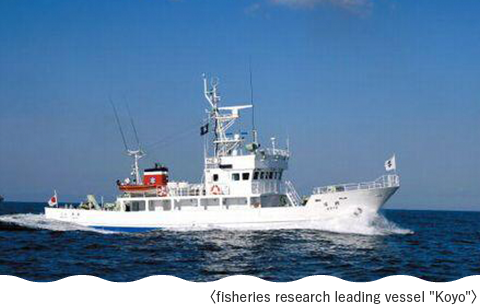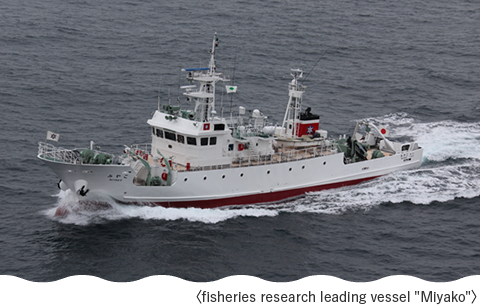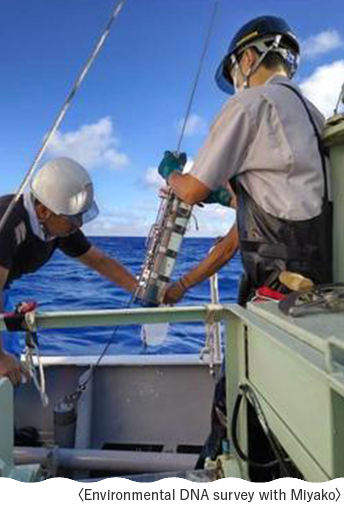
A. I joined the Tokyo Metropolitan Government (TMG) in 2004. I worked for six years at the Hachijo Branch Office of the Islands Area Research and Development Center for Agriculture, Forestry and Fisheries, and at the Fisheries Center, Industry Section, Ogasawara Island Branch Office for eight years, where I was engaged in research and survey work. After that, I took charge of general affairs at the Hachijo Branch Office for four years and currently at the Oshima Branch Office for one year.
A. Under its mission to promote the integrated development of the agriculture, forestry, and fisheries industry in the Izu and Ogasawara Islands, the Tokyo Metropolitan Islands Area Research and Development Center for Agriculture, Forestry and Fisheries supports the agriculture, forestry, and fisheries conducted in the rivers, seas, and islands of Tokyo from Okutama to Okinotorishima Islands in the southernmost part of Japan, through its technical capabilities in testing and research and extension guidance.
A. I joined in 2014 and spent the first four years working in the Fisheries Promotion, Oshima Branch Office, Islands Area Research and Development Center for Agriculture, Forestry and Fisheries, Bureau of Industrial and Labor Affairs, TMG. Next, I was in charge of the Fisheries Coordination, Fishery Section, Agriculture, Forestry and Fishery Division, Bureau of Industrial and Labor Affairs, where I worked for three years. Then, I returned to the Fisheries Promotion of the Oshima Branch Office, where I worked for two years. And now, I belong to the Industry Division of the Ogasawara Fisheries Center in the Ogasawara Island Branch Office, Bureau of General Affairs.
Tanaka: I conduct testing and research and provide extension guidance to promote the sustainable development of the fisheries industry as an essential industry in the Izu Islands and the revitalization of the local economy.
Funabashi: The fisheries profession involves various activities concerned with promoting fisheries in the TMG. I have been involved in research on resource management of alfonsinos and other species at the Oshima Branch Office and in coordination work related to the orderly operation of fisheries at the Fisheries Section.
A. It owns five vessels. Japan's Exclusive Economic Zone(EEZ) is the sixth largest in the world, and 38% of it, or 1.71 million square kilometers, is Tokyo's survey area. "Yashio" is responsible the northern ocean area in the Izu Islands across the kuroshio current, and "Takunan" do the southern Izu Islands. "Koyo" is responsible for the waters in the Ogasawara Islands, and "Miyako" opelates covers Tokyo's wider ocean area, including Minamitorishima Island and Okinotorishima Islands. "Kamome" handles diving surveys in shallow seas.

 Q. Please give us an overview of Koyo and Miyako.
Q. Please give us an overview of Koyo and Miyako.
A. Koyo was completed in February 2007. She has a gross tonnage of 87 tons, a total length of 33.07 meters, and a maximum speed of 14.2 knots. The vessel is resistant to waves, and her design is highly maneuverable and stable in waves. The ship is made of steel and partly composed of corrosion-resistant aluminum alloy. The main engine is environmentally friendly, with excellent fuel efficiency, low NOX, and low CO2 emissions. With a range of 2,000 nautical miles, the vessel can thoroughly survey the Okinotorishima Islands area. She has a full-mounted sonar, which is perfect for searching for migratory fish, observation equipment for measuring water temperature and salinity at depths of up to 1,500 meters, and a seafloor topographic survey device that enables a three-dimensional view of the seafloor topography at depths of up to 1,000 meters. She is a fisheries research and leading vessel that excels in research capabilities.
Miyako was completed in February 2012. She has a gross tonnage of 189 tons, a total length of 42.93 meters, and a maximum speed of 14.8 knots. She is a third-class fishing vessel engaged in surveys, research, guidance, and control related to fishery promotion in the Izu Islands and Ogasawara Islands ocean areas. She is equipped with survey equipment and enhanced survey functions. Regarding the ship type, she has a single-layer deck with a forecastle and bridge, and excellent maneuverability, sufficient stability, and seaworthiness. The main engine is an "Engine International Air Pollution Prevention Certificate" certified product with low NOX, low fuel consumption, and low CO2 emissions, making it environmentally friendly. Onboard equipment is operated in a centralized manner for efficient operation. In addition, she has light workability, considering occupational safety and hygienic living facilities, even on long voyages.


Tanaka: When I was assigned to the Koyo, it was used for surveying Okinotorishima Islands about twice a year, departing from Futami Port at Chichi-jima Island, arriving at the on-site seas in two days, conducting a survey for about two days, and returning to port in two days.
Funabashi: In the business plan of the Islands Area Research and Development Center for Agriculture, Forestry and Fisheries, Miyako is to conduct a survey once a year. The voyage between the Oshima Branch Office and Okinotorishima Islands takes less than three days each way by Miyako.
 Q. Tell us about the efforts you're currently making on the Okinotorishima Islands.
Q. Tell us about the efforts you're currently making on the Okinotorishima Islands.
A. We conduct oceanographic observation, plankton net, troll, environmental DNA, and reef-encircled surveys to understand marine resources in the ocean area around Okinotorishima Islands. In the oceanographic observations, we use CTD equipment to observe water temperature, salinity, and other parameters at depths of up to 1,000 meters to obtain environmental data for the on-site ocean area. At four specific points in the east, west, south, and north of Okinotorishima Islands, we measure vertical profiles of water temperature, salinity, and chlorophyll fluorescence values, as well as weather, cloud cover, cloud form, waves, swells, and transparency. These provide essential information for the fisheries industry. In plankton net surveys , we collect fish eggs, larvae, and juveniles. These surveys provide ecological information on vital fisheries species in Tokyo, such as alfonsinos and skipjack tuna around Okinotorishima Islands. On one occasion, we collected a Japanese eel larvae. In the troll survey, we conducted a test run on skipjack, an important fisheries species in Tokyo. We also investigate the feasibility of fishing by obtaining data on their occurrence and catch per unit of time and we also conduct ecological research on their migration by performing mark-recapture. In the environmental DNA survey, we analyze DNA contained in seawater to estimate the organisms in the water. This method is efficient because water sampling per time can be done in a short time. This allows us to conduct surveys to search for valuable fisheries species within a limited time. For the reef-encircled surveys, we enter the reef by onboard boats and dive to determine the status of coral colonization and the growth of giant clams.

Tanaka: Every year, I surveyed the seas on board the Koyo from June to September when sea conditions were good. The survey schedule will be a total of 5 to 6 days, including a 4-day round trip voyage and 1 to 2 days of research. The weather is generally good during the summer months unless a typhoon occurs, but sometimes, a locality of low pressure occurs, and wave heights can be as high as three meters.
Funabashi: I was involved in four surveys in 2016, 2017, 2021, and 2022. The surveys in 2016 and 2017 were conducted in June and May, respectively. Since there were almost no typhoons during these periods, we stayed at Okinotorishima Islands for over three days and ran the surveys under calm sea conditions. On the other hand, in 2021 and 2022, the surveys were conducted from October to November. During this period, sea conditions between Oshima and Okinotorishima Islands deteriorated, and we sometimes encountered rough seas during our voyage to Okinotorishima Islands. While there were some swellings and winds, the sea conditions around Okinotorishima Islands were relatively calm. However, we stayed there for about half a day, considering the weather conditions on the way.
Tanaka: Since no port is nearby, we cannot evacuate in the event of sudden weather changes or equipment failure. In addition, because the area is out of radio range, we use satellite links. The communication costs are high, and the lines do not connect well, making it difficult to obtain information such as weather conditions and to make emergency phone calls.
Funabashi: In the case of Miyako, the entire survey of Okinotorishima Islands takes at least one week. Miyako is large compared to the fishing boats of local fishermens, but it is not large enough to withstand rough weather. Therefore, we must consider weather conditions first. We also need to consider other research issues besides the Okinotorishima Islands survey and the work-life balance of the Miyako crew. The most crucial aspect is to devise a survey plan for such situations.
Tanaka: In the surveys with Koyo, we compare environmental data, catch data, and growth data of fisheries organisms with historical data at the office after the vessel arrives at the port to comprehend annual and seasonal changes and the amount of growth of the organisms.
Funabashi: We outsource analyses one part of that require a high level of skill and time, such as assessing samples collected by plankton net surveys and environmental DNA analysis. For the assessment and measurement of catch from fishing surveys, we bring the work back to our offices and do it on board. In addition, we have also calculated fishing efficiency and given a graphic (visualized) representation of of the oceanographic observation results.
Tanaka: Each person has a bed in the surveyor's room, where they sleep at night when there is no survey. I eat three meals daily in the messroom with the ship's crew. The rest of the time, I am basically on the bridge (control room), monitoring foreign vessels and other vessels.
Funabashi: During surveys, we work day and night depending on the content of the study. Especially in the Okinotorishima Islands survey, we worked in the daytime under intense sunlight. On the other hand, the ship's inside is air-conditioned and comfortable. During breaks and transportation, we spend time reading and conversing with the crew on watch duty (watch at sea.)
A. When surveying Okinotorishima Islands, we monitor the fishing grounds during our stay on the island and when traveling to and from the island. When we find a Japanese or foreign vessel, we record the AIS (Automatic Identification System) information, anchor our ship, and notify the 3rd Regional Coast Guard Headquarters if a violation is suspected.
Tanaka: During the two-day voyage, when we sailed out of the Ogasawara Islands where we saw only the sea in all directions, I felt a sense of security and gratitude for the land when we arrived at Okinotorishima Islands.
Funabashi: Within the vast coral reef zone are the two islets of Okinotorishima Islands. I was able to see these islets when I conducted a reef-encircled survey. It was a precious experience to actually see these islands and the southernmost point of Japan, which are rarely seen, with my own eyes.
Tanaka: I hope they know even a little more now about the various efforts being made at the Islands Area Research and Development Center to maintain order in the territorial waters and research related to fisheries.
Funabashi: Although Okinotorishima Islands belongs to Ogasawara Village in Tokyo, its location is far from the city center. For this reason, Tokyo residents may not easily see the connection between the Okinotorishima Islands survey and their own lives. However, the existence of Okinotorishima Islands has greatly expanded Japan's exclusive economic zone. The significance of conducting fisheries research in such an area is not minor. We hope you now have a better understanding of our activities.